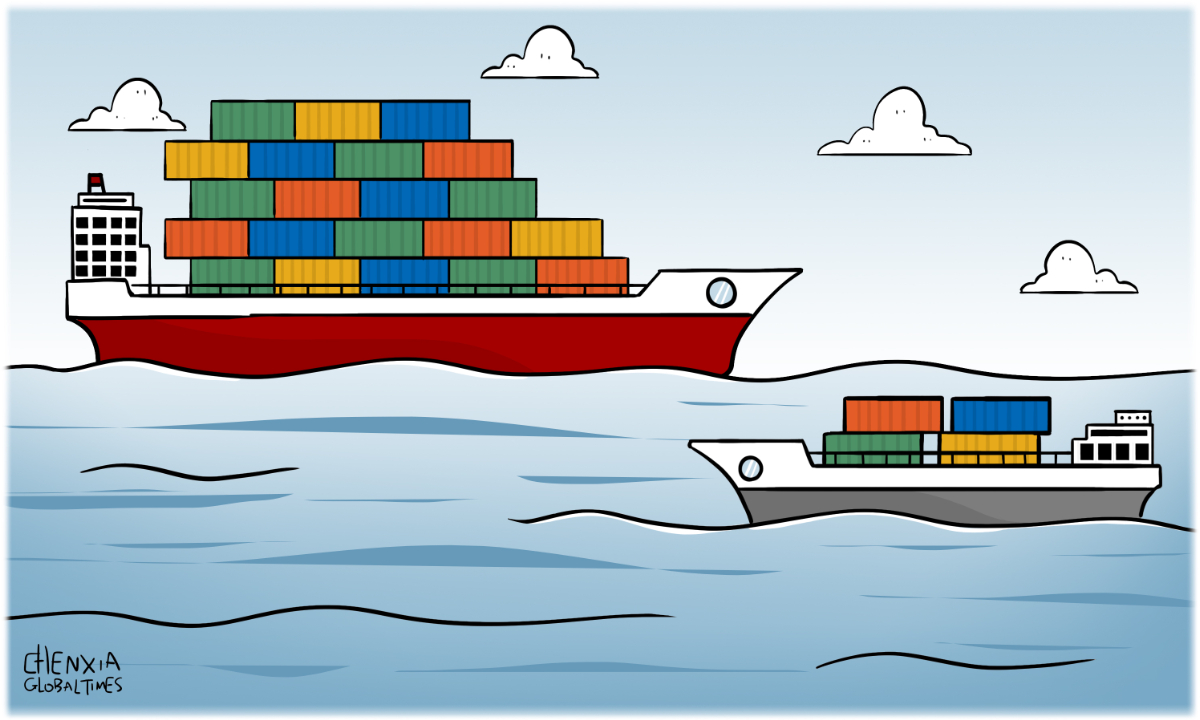
Illustration: Chen Xia/Global Times
As Omicron flare-ups in China's manufacturing hubs, like Guangdong Province and Shanghai, disrupted supply chains, Vietnams Q1 economic figures appear to show promising outlook amid the pandemic.
According to Vietnams General Statistics Office, Vietnams economy expanded by 5.03 percent in Q1 of 2022, compared with the same period of last year, surpassing China which grew 4.8 percent. Whats more, Vietnams foreign trade rose to $176.35 billion in Q1, a year-on-year rise of 14.4 percent. In comparison, China's Q1 foreign trade rose 10.7 percent in yuan terms.
If the numbers are not telling enough, recent Vietnamese media reports that business mogul Li Ka-shing invested billions in Vietnam's infrastructure after retreating from the UK have surely sent shockwaves across Chinese market watchers. Lis investment has long been viewed as a market vane.
As Southeast Asia eases its epidemic restrictions and China continues to battle Omicron flare-ups in its major cities, a new wave of headlines emerged over whether factory orders will continue to flow out of China, and if China should have a sense of crisis as global manufacturing may be weaning off dependence on the worlds second largest economy and turning to countries like Vietnam.
China began its reform and opening-up in 1978. Vietnam followed China's footsteps and started its own market reform known as "Doi moi" in 1986. For the past decades, economic growth on both countries has been remarkable. But the eruption of a trade war between the US and China in 2018 has accelerated a fourth wave of industrial chain transfer, with countries like Vietnam and Mexico emerging as the biggest winners of the trade disputes. Vietnams trade with the US has grown significantly since 2018. The latest data showed Vietnams trade surplus with the US rose to $81 billion in 2021 from $63 billion in 2020, hitting an all-time high, Reuters reported.
From an economic and population perspective, it is unlikely for Vietnam to absorb a significant share of manufacturing from China. According to the World Bank, Vietnams labor force is only 7 percent the size of China's. This means that even if Vietnam succeeds in attracting manufacturing in sectors such as electronics and textiles, it cannot replace China's overall production.
Despite a trade war and the pandemic, China's complete supply chains and strong production capacity have proved to be resilient to global shocks in the past few years and the countrys share in global manufacturing is unshakable, at least in the short term.
It is true that Vietnam has taken over the final assembly of some electronic products but China's overall manufacturing levels have remained consistently high.
For example, between 2019 and 2021, Apple decreased the number of its manufacturing locations in the Chinese mainland from 48 percent to 42 percent, most of which was a shift of labor-intensive work to Vietnam. But Apple also added 14 new Chinese suppliers, many of which are high-value and knowledge-intensive manufacturers specializing in optical components, sensors and connectors, the Maritime Executive reported.
The structure of China-Vietnam trade also shows complementarities rather than competition. Vietnams exports to China focus on fruits, aquatic products, textiles and electronics, while the country relies heavily on China for materials and equipment for its labor-intensive manufacturing. In fact, China is Vietnams largest intermediate supplier, accounting for nearly one-third of all Vietnams imports of intermediate products in manufacturing, according to data from the OECD. Vietnams integration with China has risen over the years with higher dependency on Chinese inputs for production, according to a report from the Carnegie Endowment for International Peace.
China's other advantage is its giant middle class and a huge domestic market. The McKinsey analysis previously estimated that the Chinese middle class could reach 550 million by 2022, more than one-and-a-half times the entire US population, CNBC reported. Companies that want to tap the massive Chinese market will naturally want to move manufacturing closer to their customers.
Chinese government fully recognized the difficulty Chinese manufacturing is currently facing. "This year, due to domestic and external factors, the growth of import and export is much lower than previous years and is under immense pressure. We must find ways to retain orders and stabilize foreign trade," Chinese Premier Li Keqiang said at the State Council's Executive Meeting on May 5. He vowed to ensure stability in the production and circulation in foreign trade, work out lists of key foreign trade enterprises and support their production, logistics and employment.
For the foreseeable future, Vietnam will continue to remain an attractive market for foreign investment and a destination for supply chain diversification, but its ability to bite into China's share of manufacturing is limited.
The author is an editor with the Global Times. bizopinion@globaltimes.com.cn




